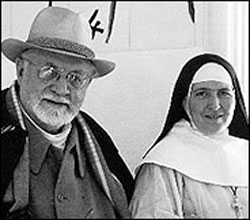Sister Jacques-Marie, Influence for Matisse's Rosary Chapel, Dies
By JOSEPH BERGER
Published: September 29, 2005
Sister Jacques-Marie, the plainspoken Dominican nun whose unlikely friendship with Henri Matisse resulted in the Chapel of the Rosary that he regarded as his masterpiece, died on Monday at a convent in Bidart, a village on the Basque coast of France.
Skip to next paragraph
Hélène Adant, courtesy of Barbara Freed
Sister Jacques-Marie and Henri Matisse around 1948.
Sister Marie Pierre, a member of the Vence Dominicans, the branch of the sisterhood that runs the Chapelle du Rosaire des Dominicains de Vence, said Sister Jacques-Marie died after having long been ill with respiratory and other ailments. Sister Marie Pierre said that she was not certain of Sister Jacques-Marie's age. However, Barbara Freed, a professor of French studies at Carnegie Mellon University who directed a 2003 documentary about the friendship, "A Model for Matisse: The Story of the Vence Chapel," said she was 84.
When the news media learned of the friendship around the time of the opening of the chapel, in Vence, France, in 1951, there were suggestions that the affection was more than platonic, but Sister Jacques-Marie, sometimes firmly, sometimes coyly, rejected such innuendos.
"I never really noticed whether he was in love with me," she said in a 1992 interview in Paris-Match magazine. "I was a little like his granddaughter or his muse, but he was always a perfect gentleman."
Sister Jacques-Marie met Matisse in 1942, when she was a student nurse named Monique Bourgeois and Matisse, in his early 70's and recovering from intestinal cancer, advertised for a "young and pretty night nurse." She propped up his pillows, read to him and took walks with him, and her impish wit and straightforward conversation enchanted him.
"As a painter he loved the splendid mass of her dark hair and the way her neck rose from her shoulders like a white tower," Hilary Spurling, his biographer, wrote.
When her assignment ended, he asked her to pose for him, and she reluctantly consented.
"I was rather surprised, for I had never been considered a beauty," she wrote in a 1993 book about their friendship.
Matisse dressed her in a sleeveless chiffon evening frock with a plunging neckline. The disciplined country woman was dismayed by the portrait he produced, titled "Monique in Gray Robe." "It was just lines and blobs of color," she said. But she sat for three other oil paintings: "The Idol," "Green Dress and Oranges" and "Tabac Royal."
When Matisse moved 20 miles inland to Vence, serendipity brought them together again because she was convalescing from tuberculosis at a Dominican-run rest home across the street from his home. Around the same time, and disregarding Matisse's counsel, she entered a distant Dominican convent in 1943 as a novice.
By 1946 she was back in Vence. According to Ms. Spurling's book, "Matisse the Master," the lonely Matisse "found warmth and comfort in the uncomplicated affection" of the nun. Accounts of the chapel's genesis vary, but according to Ms. Freed, the filmmaker, Sister Jacques-Marie sketched an Assumption for Matisse and he urged her to turn it into a stained-glass window. It happened that the rest home, Foyer Lacordaire, was hoping to convert a ramshackle garage used for prayer into a full-fledged chapel, and Matisse wondered if displaying the window could help raise money.
With the aid of a monk convalescing at the rest home, Matisse roughed out a sketch for a chapel, and Sister Jacques-Marie made the working model. Soon Matisse immersed himself in every aspect of the chapel, from the brushstroke sketches of a Stations of the Cross mural to the vestments and the slender Crucifixion altarpiece. The stained-glass windows, with one pair, "Tree of Life," suggestive of a flowering cactus, are regarded as particular triumphs; they allow lemon-yellow, bottle-green and blue light to play capriciously against white-tiled walls and the marble floor.
Sister Jacques-Marie did preliminary design work and offered candid evaluations. As important, she ran interference with her local superior, who disapproved of a chapel designed by an artist known for his nudes. In the end, Matisse described the chapel as "their shared project." When Sister Jacques-Marie told Matisse that she believed he was inspired by God Almighty, he replied gently, "Yes, but that god is me."
In the months before Matisse died in 1954, Sister Jacques-Marie tried to get him to agree to be buried in his own chapel. Instead he was buried in Nice. But Sister Jacques-Marie, who leaves only a sister, is to be buried on Saturday, in Vence, near the chapel.






 Enviar a un amigo
Enviar a un amigo Añadir comentario
Añadir comentario








